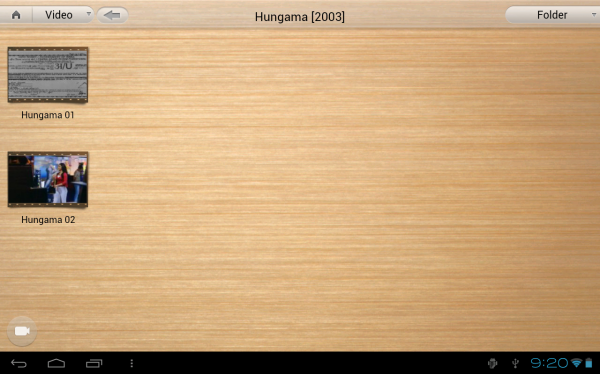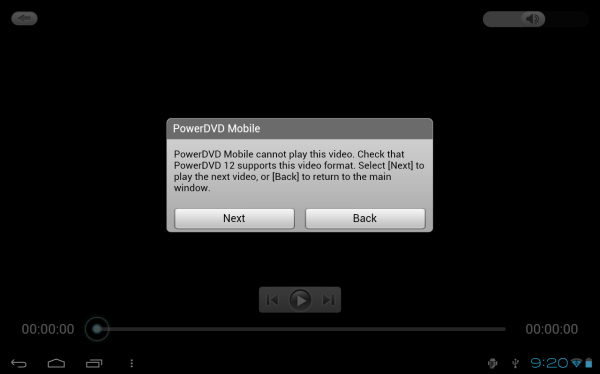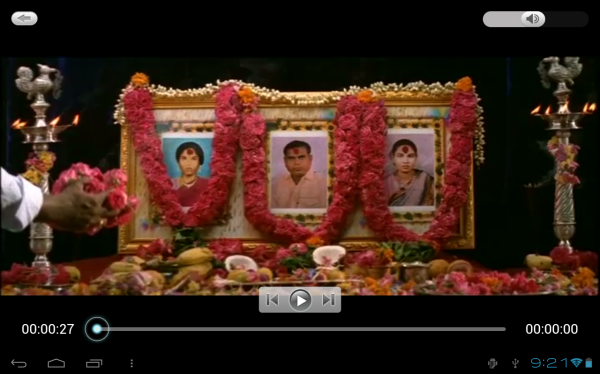CyberLink PowerDVD 12: Complementing Your Mobile Lifestyle
by Ganesh T S on January 31, 2012 9:01 AM EST- Posted in
- Home Theater
- HTPC
- Blu-Ray
- CyberLink
PowerDVD Mobile v4 is available in the Android market as well as the Apple app store. Upon installation, a code (present in the Home Media section of PowerDVD 12 Ultra under PowerDVD Mobile) needs to be entered to activate the app. PowerDVD Mobile talks to the DLNA server run by PowerDVD on the PC only. By default, the CyberLink DLNA server doesn't share any media. It needs to be explicitly told to share the library with the home media (DLNA) clients.
Coming back to the Android app, CyberLink presents the various media options in one row. On choosing a category, all the local media on the device is displayed for playback first. Choosing the Home Media option makes the app poll for the media server. Only the CyberLink DLNA server is visible through the app. By default, all the files in the library are listed alphabetically. The only other way to view the library is with the folder view.
Unfortunately, all visible files are not necessarily available for playback. For exmaple, I had an XviD movie file which, though visible, caused PowerDVD Mobile to error out.
However, I was able to get some H.264 files to work.
Of course, the most interesting aspect was what could be done with the files in the media library on the device. Upon selecting a media file, it is possible to beam it across to another DLNA Media Renderer (I had two other renderers in my network, a Popcorn Hour A300 and my Sony KDL46EX720 TV). It is also possible to save a transcoded stream to the local device.
The transcoding process occurs on the server side, and it doesn't take advantage of QuickSync. In addition, transcoded archiving seems to work only for media files which could be successfully played back in the initial attempt. This is a good way to get media onto the device for enjoyment outside the network, but it is very puzzling as to why unsupported media doesn't get transcoded into a valid profile.
While I tested the app out with the HTC Vision and the Motorola Xoom, Jarred used a Qualcom MSM 8x60 based tablet as well as an iPod Touch to test the same app on his side. Jarred couldn't get the iOS app working as smoothly as the Android app, but, suffice to say, both of us spent more time with the Android app. All our observations and suggestions for CyberLink are presented in the next section.
























41 Comments
View All Comments
sholling - Wednesday, February 1, 2012 - link
It seems like the only real change from 11 to 12 is the ability to get rid of the giant advertizement screen. The settings screen still doesn't let you change audio defaults or at least make them stay changed, and it still doesn't support ISOs despite the feature chart. I wish the reviewer had actually tested that feature because it would have saved me $50. Net time I'll be a lot less trusting when a reviewer here makes a claim.ganeshts - Wednesday, February 1, 2012 - link
Whoa! Of course it plays ISOs when it is mounted with Virtual Clone Drive. Definitely tested and it works.ganeshts - Wednesday, February 1, 2012 - link
And of course, I have mentioned that in the concluding section too:Next time around, it would be really nice to not blame the reviewer when the necessary information is actually available in the review and is clearly explained.
sholling - Wednesday, February 1, 2012 - link
If BD ISO is going to be claimed in the table then it needs to be in reference to direct support not through a some 3rd party tool that's doing the heavy lifting. Any program can access an ISO if a 3rd party program is doing the work for it. The author needs to go back and correct the table to read "ISOs supported through 3rd party tools only". Many readers are going to be coming from appliances alike the WDTV Live and NeoTV550 where BD ISO support actually means BD ISO support.sholling - Wednesday, February 1, 2012 - link
BTW Other than the ISO thing it was a nice review.cjs150 - Thursday, February 2, 2012 - link
I have had bad experiences - never again.If I like a Blu ray I will rip it off the disc down to my NAS (any number of programs can do this) and then replay using a low power HTPC (still looking for the perfect one).
Yes it may be a grey area but my standalone Blu-ray player does a brilliant job - until you get to a quiet bit in the movie. I want to hear the movie not the Blu-ray player (to be fair it is probably just sound of disc going round at high revs).
I particularly enjoyed the lack of support for forced sub-titles - so when I watch Battle of Britain and Germans are speaking German I will not get the sub-title translations?
ganeshts - Thursday, February 2, 2012 - link
Forced subtitles work off Blu-rays, just not off standalone files.The advantages of ripping a Blu-ray to disk are many, but not everyone wants to do that (and it is definitely a legally gray area at least in the US)
Golgatha - Thursday, February 2, 2012 - link
There is nothing grey about it. The DMCA makes it completely illegal to do a legally grey thing. Namely the exercise of your fair use rights. Sorry to derail the thread. Nice review of apparently improved software (since I last used it anyway). Customer service, cost of upkeep, and support of the product should be in the review too. Those are the main reasons I chose ArcSoft's TMT5.maglito - Thursday, February 2, 2012 - link
It seems no software player supports this niche. It makes plenty of sense for current HTPC projector owners to get a 2nd projector identical to their current one(cheaply on the used market), some passive filters, cheap $1/pair glasses and possibly go to a silver screen depending on what they use(if their current screen won't maintain polarization of the reflected light). In fact JVC projectors are ideal for this as all colors are already polarized at 0 degrees (I have a JVC RS-1 from back in 2006 and I know Anand got a RS-2 shortly after).If any video card manufacturer or media player software supported this output type from 3d Blu Ray or 3D MKV files that would help many people investigating this solution out tremendously. The current work arounds to make this work are a bit of a joke.
As usual, nice write up Ganesh.
justniz - Thursday, February 2, 2012 - link
I never liked the way PowerDVD apparently has to take over your whole system just to play a DVD.Does PowerDVD 12 still need to switch your whole GUI from glass mode to basic mode when it runs? That was always retarded, especially on PCs with high end video cards.